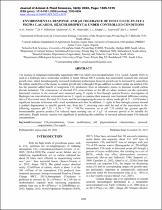| dc.contributor.author | Amosu, Albert Oluwatobi | |
| dc.date.accessioned | 2023-03-16T07:55:27Z | |
| dc.date.available | 2023-03-16T07:55:27Z | |
| dc.date.issued | 2022 | |
| dc.identifier.citation | Amosu, A. O. (2022). Environmental response and ph tolerance of induced co2 in ulva rigida c.agardh, 1823(Chlorophyta) under controlled conditions. Journal of Animal & Plant Sciences, 32(6),1605-1615. https://doi.org/10.36899/JAPS.2022.6.0570 | en_US |
| dc.identifier.issn | 2309-8694 | |
| dc.identifier.uri | https://doi.org/10.36899/JAPS.2022.6.0570 | |
| dc.identifier.uri | http://hdl.handle.net/10566/8601 | |
| dc.description.abstract | The increase in integrated multitrophic aquaculture (IMTA), where seaweed (particularly Ulva rigidaC.Agardh, 1823) is
used as a feedstock and a wastewater scrubber in South African IMTA systems, has necessitated research into seaweed
growth rates, which hassubsequently increased production technologies.Seaweed growth can be increased by controlling
the culture media.One of the means to control growth rate is through CO2gas addition to culture media via aeration.This
has the potential added benefit of usingwaste CO2 production from an alternative source to decrease overall carbon
dioxide emissions. The consequence of elevated CO2 concentration on the pH of culture medium and the equivalent
functional reactions in the seaweed were examined using U. rigida in flow-through systems.Toxicity investigation of
Hydrogen ion concentrations werecarried out on U. rigida to examine their anatomy cum functional differences arising
due to CO2 exerted stress. Elevated CO2 levels and the accompanying decrease in culture media pH (4.71 – 6.67) leadto a
significant decrease in biomass with varied sporulation activities. In addition, U. rigida in flow-through systems showed
a gradual degeneration in specific growth rate, from day 7, atvarying rates until the end of the experiment in the
following sequence pH 7.20 > 8.20 > 7.50 > 7.80.The treatment set at pH 7.20 yielded the greatest specific
biomassandthe greatest produce.The cultured input stocking rate of 5 g.l-1 of seawater proved to be suitable for
cultivation. ThepH toxicity reaction was significant in predicting the suitability of seaweed cultured under CO2 induced
concentrations. | en_US |
| dc.language.iso | en | en_US |
| dc.publisher | PAS FORUM | en_US |
| dc.subject | Biodiversity | en_US |
| dc.subject | Conservation | en_US |
| dc.subject | Biology | en_US |
| dc.subject | Seaweed | en_US |
| dc.subject | South Africa | en_US |
| dc.title | Environmental response and ph tolerance of induced co2 in ulva rigida c.agardh, 1823(Chlorophyta) under controlled conditions | en_US |
| dc.type | Article | en_US |

